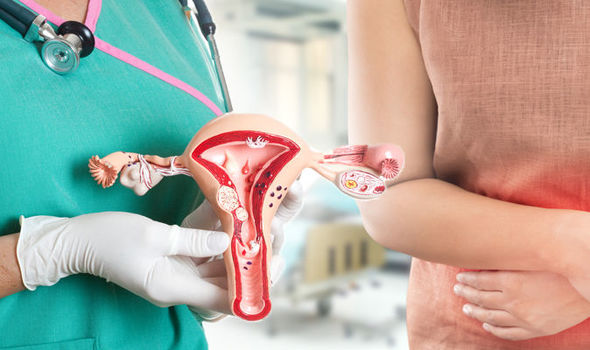News - Mon, 09/30/2019 - 16:23
Hysterectomy - Surgery to remove the uterus
Last update 09/27/2024 - 17:58

What is hysterectomy?
A hysterectomy is surgery to remove the uterus. The uterus is the part of a woman's body that carries a baby if she is pregnant.

Are there different kinds of surgery for hysterectomy?
Yes, there are 4 main kinds of surgery:
- Vaginal hysterectomy – To do a vaginal hysterectomy, the doctor makes cuts inside the vagina and removes the uterus through the vagina. Vaginal hysterectomy leaves no visible scars, but it is not always possible. Sometimes doctors do vaginal hysterectomy but also use the tools used in laparoscopic hysterectomy. This is called a "laparoscopic-assisted vaginal hysterectomy." If this approach is used, the uterus is removed through the vagina.

- Laparoscopic hysterectomy – To do a laparoscopic hysterectomy, the doctor inserts a tiny camera and tools through small openings in the belly. Then he or she removes the uterus in a bag through one of the holes or through the vagina.
-
In gynecology, laparoscopic surgery is used for many procedures that were traditionally performed via laparotomy. These are performed for benign and malignant disease. Conventional (also referred to as "straight stick") and robotic approaches are used.
Potential advantages of laparoscopy over laparotomy include shorter operative time (for some, but not all, procedures), smaller scars, faster recovery, decreased adhesion formation, and decreased cost. When comparing laparoscopy with laparotomy for benign gynecologic conditions, clinical evidence clearly has showed that the overall risk of minor complications (e.g., fever, wound or urinary tract infection) is lower in women undergoing laparoscopic procedures.
- Robotic hysterectomy – In a variation of the laparoscopic approach, the tools used for the surgery are attached to a robot that the doctor controls. This is called "robot-assisted laparoscopy."
-
Abdominal hysterectomy – To do an abdominal hysterectomy, the doctor makes a cut in the belly and removes the uterus through that opening. This is only done when a woman can't have the other types of hysterectomy. That's because it takes longer to recover from an abdominal hysterectomy.
Why might a woman need hysterectomy?
A hysterectomy might be done to treat the following:
- Abnormal bleeding – Some women bleed too much during their period or at times when they should not be bleeding. This can lead to a condition called anemia, which can make you feel very tired.
- Fibroids – Fibroids are tough balls of muscle that form in the uterus. They can get very big and press on the organs inside the belly. They can also cause abnormal bleeding.
- Pelvic organ prolapse – Pelvic organ prolapse is when the uterus falls down into the vagina.
- Cancer or conditions that could lead to cancer – Cancer can affect the uterus or the cervix, the organ that separates the uterus and the vagina. Sometimes doctors suggest removing these organs if they show signs that cancer is about to form.
- Ongoing pelvic pain – Some women feel pain that will not go away in the area just below the belly. This is called "chronic pelvic pain." Hysterectomy can sometimes help treat this pain.
What if I do not want a hysterectomy?
Many of the conditions that are treated with hysterectomy can be treated in other ways instead. If you do not want the surgery, ask your doctor or nurse if you have other treatment options. Ask, too, what will happen if you do not have a hysterectomy.
What if I want to get pregnant?
If you have a hysterectomy, you will not be able to get pregnant. Unfortunately, if you have cancer or another serious problem, you might not be able to avoid having a hysterectomy. If you want to have children, speak to your doctor or nurse about your options.
Is the uterus the only organ that is removed during a hysterectomy?
That depends on what you want and why you are having a hysterectomy. During a hysterectomy, doctors sometimes also remove the:
- Cervix – For a vaginal hysterectomy, the cervix must be removed. For an abdominal or laparoscopic hysterectomy, the cervix can be removed or left in place. If the cervix is removed, it is called a total hysterectomy. If the cervix is left in place, it is called a subtotal or supracervical hysterectomy.
-
Ovaries and fallopian tubes – The ovaries are the organs that make eggs (which can become a baby) and female hormones, including estrogen and progesterone. The fallopian tubes carry eggs from the ovaries to the uterus. The hormones made by the ovaries help keep bones healthy and are important for other aspects of health. Women who have their ovaries removed sometimes need to take hormone pills.

If you are planning to have a hysterectomy, ask your doctor whether he or she is planning to remove your cervix and your ovaries and fallopian tubes. It is important to know this, because women who do not have a cervix need different medical care than women who do. Likewise, women who do not have ovaries sometimes need different medical care than women who do.
Should I have my ovaries and tubes removed if I have a hysterectomy?
Deciding whether or not to have your ovaries removed can be tough. You will need to think about how old you are, and about how not having ovaries might affect you.
In women who have not yet been through menopause, having the ovaries removed can lead to hot flashes, bone loss, reduced interest in sex. Therefore, removal of ovaries before menopause is usually not performed in case of hysterectomy for benign conditions. Simple removal of the uterus without ovaries does not affect at all your hormonal status and your sexual life and interest.
In women who have been through menopause, having the ovaries removed might also increase the risk of health problems, such as heart disease, but the research is still not clear. On the other hand, women who have health problems that get worse at certain times in the menstrual cycle sometimes feel better without their ovaries. Plus, in rare cases, the ovaries can develop cancer, so women sometimes choose to have them removed. Before you have surgery, ask your doctor about the pros and cons of having your ovaries removed.
The fallopian tubes are not needed if a woman is not going to get pregnant. They can be removed at the time of hysterectomy, even if the ovaries are left behind. This can lower the risk of a rare type of cancer that can start in the fallopian tubes.
What will my life be like?
Studies show that women can have happy, full lives after a hysterectomy. Many women feel better after the surgery, because they no longer have the symptoms that bothered them before.
|
Dr. Armando Librino Dr. Armando Librino is a gynaecologist obstetrician coming from French Red Cross hospital in Kourou, French Guyana, France. After graduating in Turin, Italy, where he was awarded the faculty prize for the best graduating students of the year, he worked with the best professors specialiazing in gynaecology and obstetrics in Switzerland. In particular, he was assistant head at Fribourg Cantonal Hospital, Switzerland, tightly collaborating with Prof. Jean Bernard Dubuisson, a world renowned minimally invasive gynaecological surgeon. Author of several articles in the field, Dr. Armando Librino had a university diploma in mini invasive surgery in Clermont Ferrand and in robotic surgery from Nancy University. He specializes in gynecological surgery, in particular in minimally invasive techniques such as hysteroscopy and coelioscopy. He is capable of performing all obstetric and gynecological interventions, in particular:
In addition, Dr Librino has been recognized to be highly capable for pregnancy care and obstetric pathologies. He can speak French, English and Italian. For consultation and treatment of gynecological diseases with Dr. Armando Librino, please contact us at: (84-24) 3577 1100 or send us an inquiry. |



